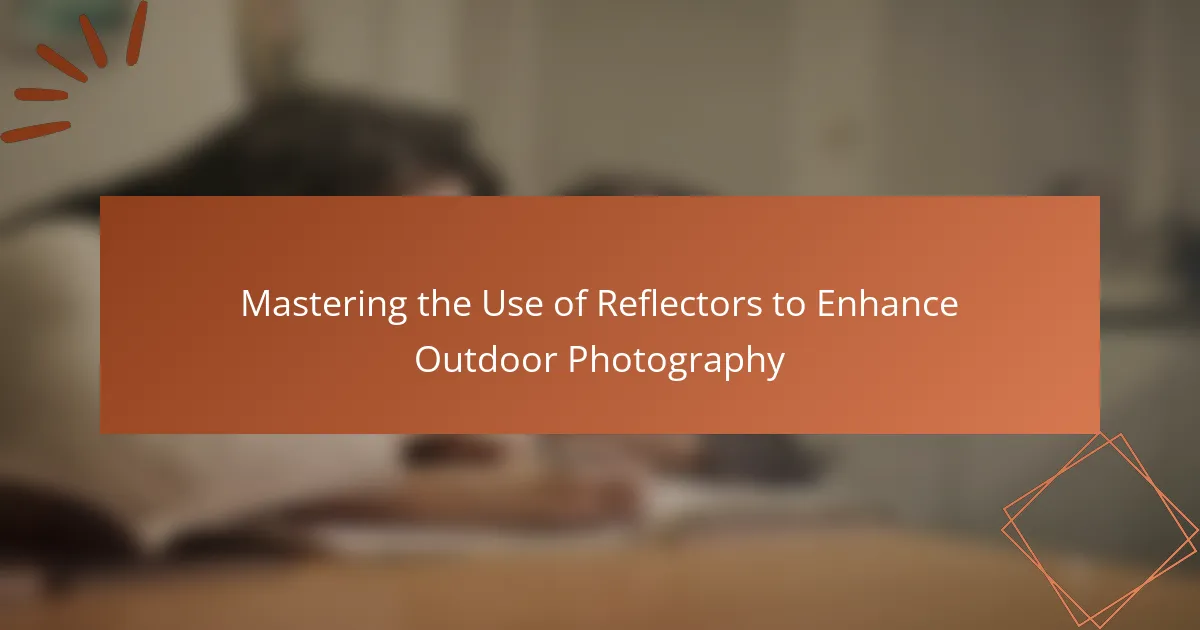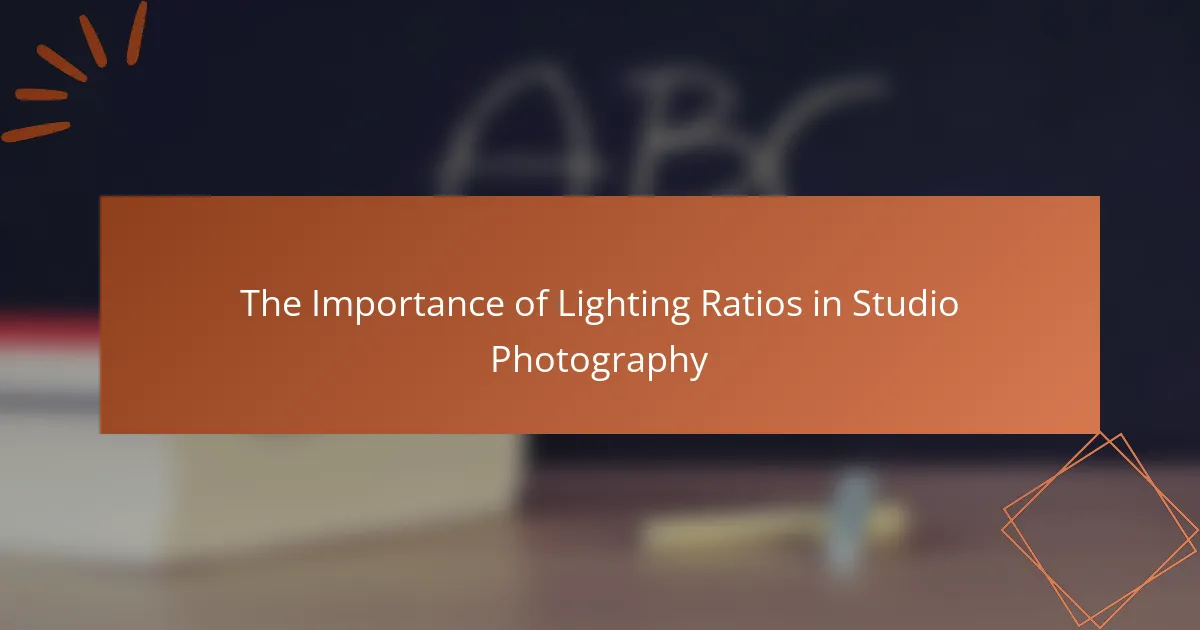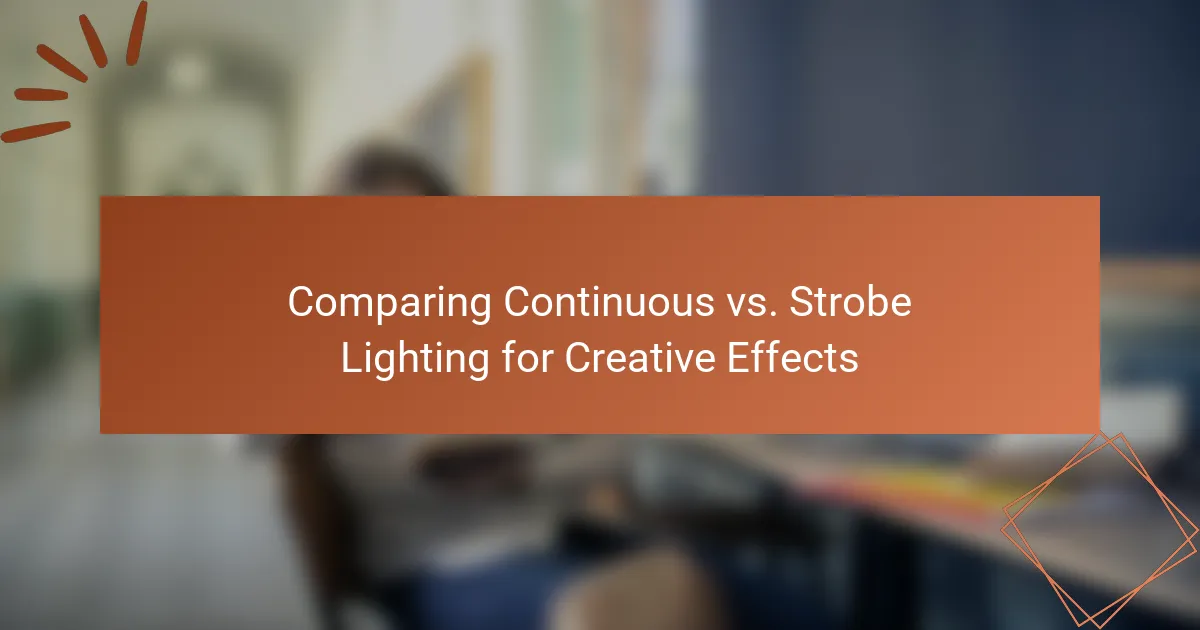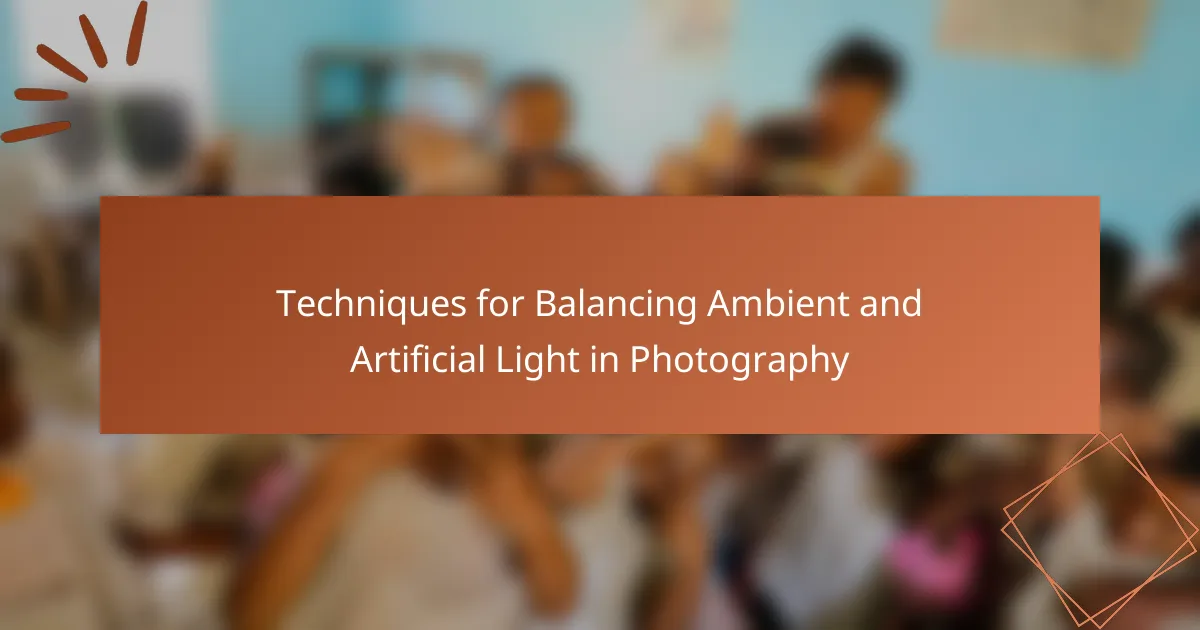Natural light techniques in portrait photography leverage natural light sources, such as sunlight, shade, and ambient light, to enhance the visual quality of portraits. Key concepts include the golden hour for soft lighting, the use of windows for flattering illumination, and reflectors to manage shadows. Different types of natural light—direct sunlight, diffused light, and reflected light—impact the aesthetic of photographs, with each type offering distinct characteristics. Understanding the direction and quality of light is essential for photographers to create appealing images, and adjusting camera settings can further optimize exposure in various lighting conditions. This overview highlights the fundamental aspects of utilizing natural light for effective portrait photography.
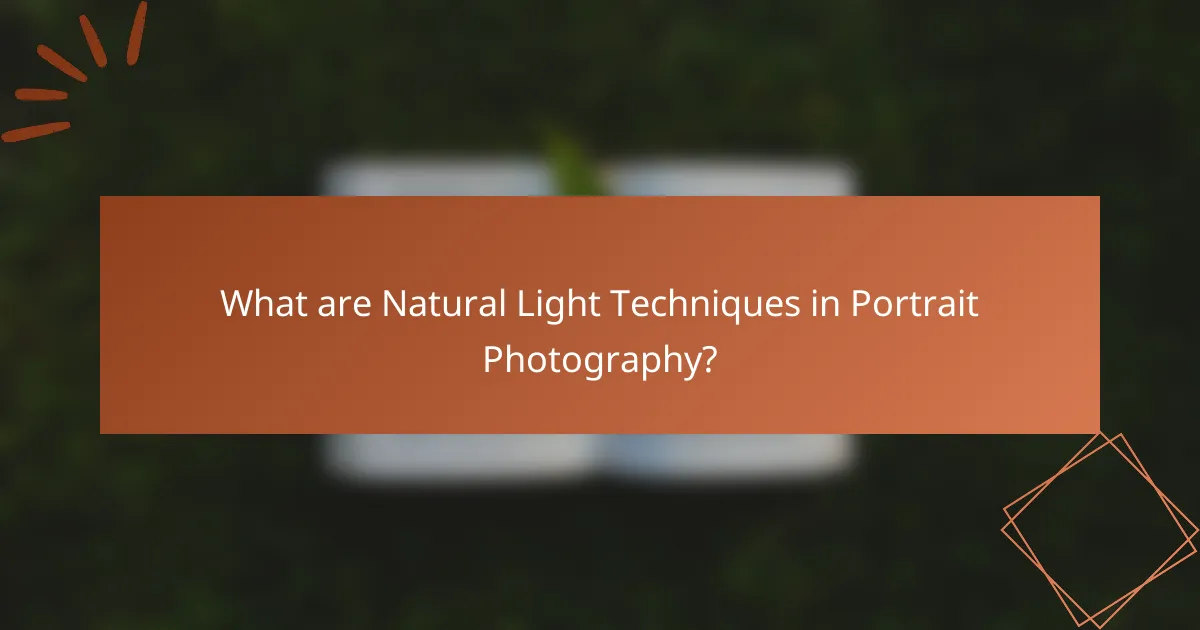
What are Natural Light Techniques in Portrait Photography?
Natural light techniques in portrait photography involve using natural light sources to illuminate subjects. These techniques capitalize on sunlight, shade, and ambient light for effective portraits. Photographers often utilize the golden hour, which occurs shortly after sunrise or before sunset, to achieve soft and warm lighting. Positioning subjects near windows can also create flattering light and soft shadows. Reflectors may be used to bounce light onto the subject, enhancing features and reducing harsh shadows. Understanding the direction and quality of light is crucial for achieving desired effects. Properly executed, these techniques can result in visually appealing and natural-looking portraits.
How do Natural Light Techniques differ from Artificial Lighting?
Natural light techniques utilize sunlight as the primary source of illumination, while artificial lighting relies on man-made light sources. Natural light varies in intensity and quality throughout the day. It creates soft shadows and highlights, enhancing the subject’s features. In contrast, artificial lighting can be controlled for consistency and direction. It allows for adjustments in color temperature and intensity. Natural light is often preferred for its organic feel and dynamic range. Artificial lighting can be manipulated to achieve specific artistic effects. Both methods have unique advantages in portrait photography.
What are the advantages of using Natural Light in Portrait Photography?
Natural light in portrait photography offers several advantages. It provides soft, diffused illumination that enhances skin tones. This type of lighting reduces harsh shadows, making subjects appear more flattering. Natural light is readily available, eliminating the need for complex lighting setups. It also creates a sense of authenticity and connection in photographs. According to a study by the American Society of Photographers, portraits taken in natural light often receive higher viewer engagement. Additionally, the dynamic quality of natural light changes throughout the day, allowing for diverse moods and atmospheres in portraits.
What challenges do photographers face when using Natural Light?
Photographers face several challenges when using natural light. One significant challenge is the unpredictability of weather conditions. Changes in cloud cover can dramatically alter lighting quality. Another issue is the time of day, as natural light varies in intensity and color temperature throughout the day. Midday sun can create harsh shadows, while golden hour offers softer light. Additionally, finding the right location can be difficult, as some areas may lack adequate natural light. Photographers must also consider the direction of light, which affects how subjects are illuminated. Reflections and color casts from surrounding surfaces can further complicate exposure settings. Finally, managing exposure and white balance can be tricky in changing light conditions.
Why is understanding Natural Light important for Portrait Photographers?
Understanding natural light is crucial for portrait photographers because it directly impacts the quality of images. Natural light affects skin tones, shadows, and overall mood in photographs. Mastery of natural light allows photographers to create flattering and dynamic portraits. It enables them to harness sunlight at different times of day for varied effects. For example, the golden hour provides soft, warm light that enhances subjects. Conversely, harsh midday sun can create unflattering shadows. Photographers who understand natural light can manipulate it to their advantage. This knowledge leads to more compelling and professional-looking portraits. Research indicates that lighting is one of the most critical factors in photography success.
How does Natural Light influence the mood and tone of a portrait?
Natural light significantly influences the mood and tone of a portrait. It creates a softer, more natural appearance compared to artificial light. The direction of natural light affects shadows and highlights, impacting the subject’s features. For instance, front lighting can create a bright, cheerful mood. Conversely, side lighting can evoke a more dramatic or moody atmosphere. The color temperature of natural light varies throughout the day, with golden hour light providing warm tones that enhance skin textures. In contrast, midday light can be harsh and create unflattering shadows. Photographers often use natural light to evoke specific emotions or themes in their portraits, aligning with the intended message or story.
What role does time of day play in Natural Light Photography?
Time of day significantly influences natural light photography. The angle and quality of sunlight change throughout the day. During sunrise and sunset, known as the golden hour, light is softer and warmer. This creates flattering skin tones and long shadows. In contrast, midday light is harsher and can produce unflattering shadows. Photographers often seek to avoid this time for portraits. The direction of light also varies, affecting how subjects are illuminated. Understanding these changes allows photographers to optimize their use of natural light effectively.

What are the Different Types of Natural Light?
The different types of natural light include direct sunlight, diffused light, and reflected light. Direct sunlight is bright and creates strong shadows. This type of light is often harsh and can cause overexposure in photographs. Diffused light occurs when sunlight passes through clouds or is obstructed by other objects. It softens shadows and creates a more even lighting effect. Reflected light comes from surfaces like water or walls that bounce sunlight. This type of light can add warmth and depth to portraits. Understanding these types helps photographers choose the best conditions for capturing images.
What is Soft Light and how is it achieved?
Soft light is a type of illumination that produces gentle shadows and a smooth transition between light and dark areas. It is characterized by its diffused quality, which reduces contrast and highlights. Soft light is typically achieved through the use of large light sources relative to the subject. This can include natural sources, like overcast skies, or artificial sources, such as softboxes or diffusers. When the light source is larger than the subject, it creates a more flattering and even light. For instance, shooting in the shade or during golden hour can also result in soft light conditions. The resulting effect is often preferred in portrait photography for its ability to highlight skin tones and textures without harsh shadows.
How does Soft Light affect skin tones in portraits?
Soft light enhances skin tones in portraits by creating a gentle and flattering effect. This type of lighting minimizes harsh shadows and reduces skin imperfections. It evenly distributes light across the subject’s face. As a result, skin tones appear more uniform and natural. Soft light also adds a subtle glow to the skin. This effect can be achieved using diffusers or by shooting during golden hour. Studies show that soft light is preferred in portrait photography for its ability to enhance beauty. Overall, soft light is crucial for achieving appealing skin tones in portraits.
What situations are best for using Soft Light?
Soft light is best used in portrait photography during overcast days. The clouds diffuse sunlight, creating a gentle and even illumination. This reduces harsh shadows on the subject’s face. Soft light is also ideal during the golden hour, shortly after sunrise or before sunset. The low angle of the sun produces warm, flattering tones. Additionally, using soft light indoors with window light can enhance natural skin tones. Reflectors can further soften shadows in these situations. Overall, soft light is effective for creating a natural and pleasing aesthetic in portraits.
What is Hard Light and when should it be used?
Hard light is a lighting technique characterized by sharp shadows and high contrast. It occurs when the light source is small relative to the subject. Hard light can enhance textures and details in portrait photography. It is often used when dramatic effects are desired. Photographers should use hard light during midday when the sun is high. This light creates a bold, striking appearance. It is ideal for emphasizing [censured] features. Careful positioning is essential to control shadow placement.
How does Hard Light impact shadows in portraits?
Hard light creates sharp, defined shadows in portraits. This type of lighting emphasizes textures and details on the subject’s face. The intensity of hard light leads to high contrast between light and shadow. Shadows cast by hard light are often darker and more pronounced. This effect can add drama and depth to the portrait. Photographers can manipulate the angle of hard light to control shadow placement. For example, positioning the light source low can elongate shadows. Additionally, hard light can highlight imperfections, which may not be as visible in soft light.
What are the best practices for working with Hard Light?
Use hard light to create strong contrasts and defined shadows in portrait photography. Position your subject to maximize the impact of the light source. Utilize reflectors to soften shadows where necessary. Experiment with different angles to find the most flattering light. Control the distance between the light source and the subject for varying intensity. Choose the right time of day for outdoor shooting to achieve desired effects. Hard light can enhance textures and details in the subject’s features. Understanding these practices allows for effective use of hard light in portrait photography.
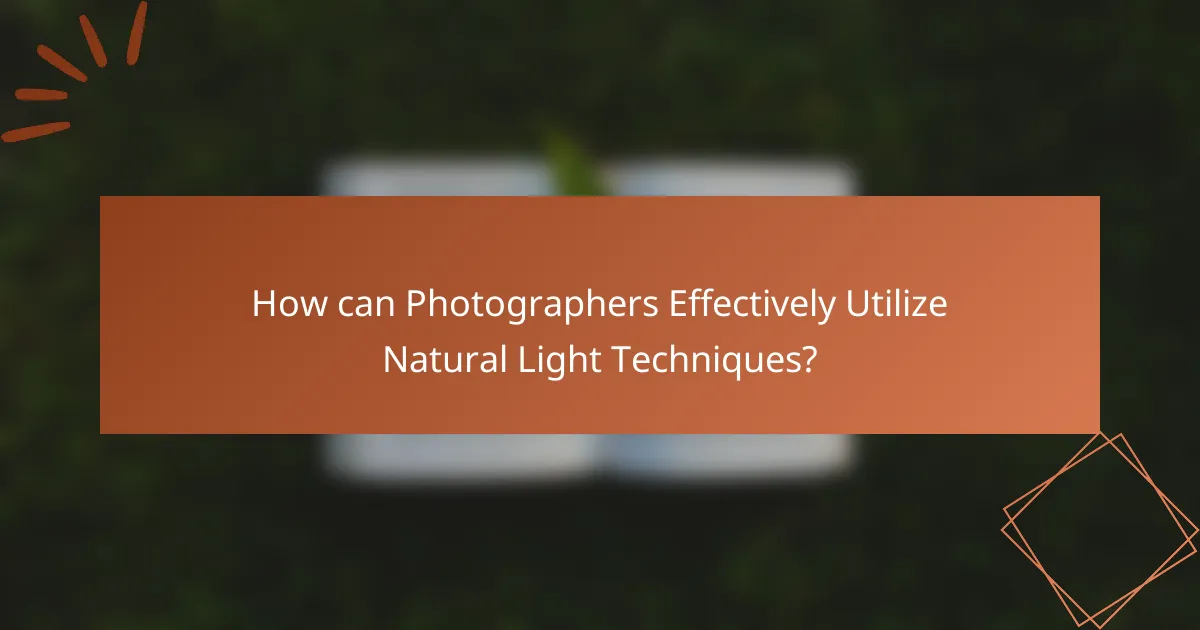
How can Photographers Effectively Utilize Natural Light Techniques?
Photographers can effectively utilize natural light techniques by observing the quality and direction of light. Soft, diffused light is ideal for flattering portraits. Photographers can achieve this by shooting during golden hour, which occurs shortly after sunrise or before sunset. They should also look for shaded areas to avoid harsh shadows. Reflectors can be used to bounce light onto the subject, enhancing illumination. Additionally, adjusting the camera settings, like ISO and aperture, allows for better exposure in varying light conditions. Using these techniques can significantly improve the overall aesthetic of portrait photography.
What are some tips for finding the best Natural Light locations?
To find the best natural light locations, seek areas with ample sunlight during golden hours. Golden hours occur shortly after sunrise and just before sunset. Look for locations with open spaces to maximize light exposure. Avoid shaded areas, as they can diminish light quality. Reflective surfaces, like water or white walls, can enhance natural light. Consider the direction of sunlight; south-facing locations often provide consistent light. Test different angles to find the most flattering light for portraits. Scout locations beforehand to assess lighting conditions at various times.
How can backgrounds influence the effectiveness of Natural Light?
Backgrounds can significantly influence the effectiveness of natural light in portrait photography. The color and texture of a background can reflect or absorb light, impacting the subject’s illumination. Lighter backgrounds tend to reflect more light, enhancing the subject’s brightness. Conversely, darker backgrounds can absorb light, creating a more dramatic effect. The distance between the subject and the background also matters. Closer backgrounds may create shadows on the subject, while those further away can allow for more diffused light. Additionally, backgrounds with patterns or distractions can divert attention from the subject. A clean, simple background often allows natural light to enhance the subject more effectively. Overall, the choice of background is crucial for achieving the desired lighting effect in portrait photography.
What should photographers consider when choosing a time for shooting?
Photographers should consider the quality of natural light when choosing a time for shooting. The golden hour, shortly after sunrise and before sunset, provides soft, diffused light. This light enhances skin tones and reduces harsh shadows. Midday sun can create strong shadows and overexposed highlights. Photographers should also consider the weather conditions. Cloud cover can soften light, creating a more even exposure. Additionally, the direction of the sun affects shadows and highlights. Photographers must plan their shooting times according to the desired effect and mood. Understanding these factors leads to better portrait photography outcomes.
What techniques can enhance the use of Natural Light in Portraits?
To enhance the use of natural light in portraits, utilize techniques such as timing, positioning, and reflectors. Timing refers to shooting during the golden hour, which occurs shortly after sunrise or before sunset. This period provides soft, warm light that flatters subjects. Positioning involves placing the subject in relation to the light source. Front lighting can minimize shadows, while side lighting adds depth and texture. Reflectors can bounce light onto the subject, softening harsh shadows and enhancing overall illumination. Using these techniques can significantly improve the quality of natural light in portrait photography.
How can reflectors and diffusers improve Natural Light outcomes?
Reflectors and diffusers enhance natural light outcomes by manipulating light quality and direction. Reflectors bounce light onto subjects, filling in shadows and creating a more balanced exposure. This technique can increase the overall brightness of the scene without adding artificial light sources. Diffusers soften harsh sunlight, reducing glare and creating a more flattering light on the subject’s skin. They help maintain detail in highlights and shadows, resulting in a more dynamic range. Studies show that using reflectors can improve image quality by up to 30% in certain lighting conditions. In portrait photography, these tools are essential for achieving professional-looking results.
What settings should be adjusted on the camera for optimal Natural Light photography?
To achieve optimal natural light photography, adjust the camera settings to enhance exposure and detail. Set a low ISO, typically around 100 to reduce noise. Use a wide aperture, such as f/2.8 to f/4, to create a shallow depth of field. Adjust the shutter speed to be fast enough to avoid motion blur, typically 1/125 seconds or faster. Utilize the camera’s exposure compensation feature to brighten or darken the image as needed. Meter for the highlights to preserve detail in bright areas. Lastly, consider the white balance setting to match the natural light conditions, typically set to daylight or auto. These adjustments will enhance image quality in natural light conditions.
What are common mistakes to avoid when using Natural Light in Portrait Photography?
Common mistakes to avoid when using natural light in portrait photography include shooting at the wrong time of day. The golden hour, shortly after sunrise or before sunset, provides the best light. Not considering the direction of light can lead to unflattering shadows. Front lighting can flatten features, while backlighting can create silhouettes if not managed properly. Failing to use reflectors can result in harsh shadows on the subject’s face. Overexposing or underexposing images due to improper metering can also diminish quality. Neglecting to adjust white balance for different lighting conditions can result in unnatural skin tones. Finally, not paying attention to the background can lead to distractions in the composition.
Understanding Natural Light Techniques for Portrait Photography focuses on utilizing natural light sources to enhance portrait images. The article covers various aspects, including the advantages and challenges of using natural light, the differences between natural and artificial lighting, and the impact of time of day on lighting quality. It also discusses types of natural light, such as soft and hard light, and offers practical tips for photographers to optimize their use of natural light, including camera settings, positioning, and the use of reflectors and diffusers. Finally, the article addresses common mistakes to avoid for achieving high-quality portrait photography with natural light.
